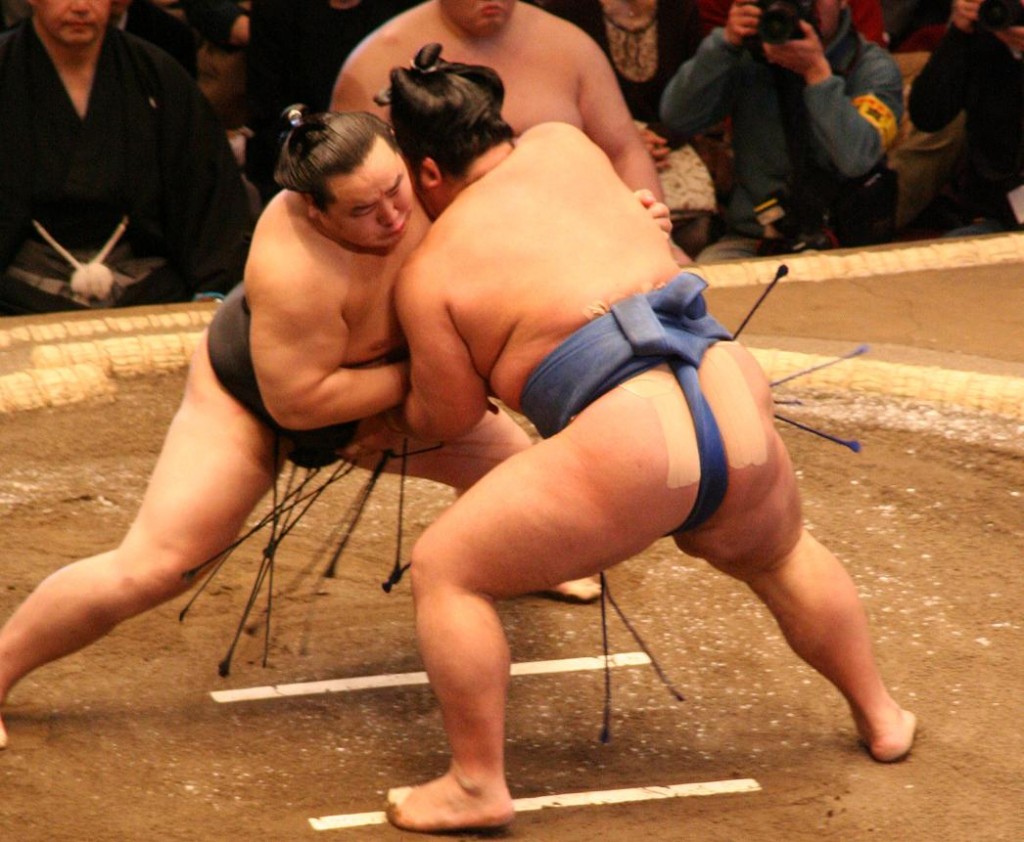
Yokozuna Asashoryu in a fight in 2008 (courtesy Wikicommons, as others below)
The Tokyo tournament is now under way (there are six tournaments a year), and as usual the wrestling is featured on Japan’s main television programme, NHK. Despite the relative weakness of Japanese wrestlers in recent years, sumo remains the country’s national sport. As Wikipedia notes, ‘In its association with Shinto, sumo has also been seen as a bulwark of Japanese tradition.’
In searching for information about the origins of sumo, I’ve come across pieces championing the wrestling as a purely Japanese phenomenon while other sites claim its origins lie in China. Personally I can’t help wondering if there isn’t a connection with Mongolian and Korean wrestling, both of which are very similar in rules. Given the spread of Siberian shamanism to the south and into the Korean peninsula, perhaps ancient forms of horsemanship and wrestling would have been introduced too.
Whatever the origins may be, there’s no doubt that sumo wrestling as it developed in Japan became closely connected with Shinto ritual, and the piece below taken from the sumotalk website illustrates the particular borrowings in some detail. Even in its secular form, it retains all the trappings of an offering to the kami.
************************************************
Historians agree that the origins of sumo date back 2000 years; however, it never really flourished as a spectator sport until the early 1600’s. Like any other social group in Japan, there are strict rules and traditions that are observed throughout the sport. The beginner watching his first sumo broadcast on television soon realizes that very little time is actually spent grappling. Rather, the wrestlers spend most of their time performing pre-bout ceremonies steeped in Shinto tradition.
Shinto is the native religion of Japan and is more a set of rituals and ceremonies than a system of beliefs or a definite code of ethics. The word itself means “way of the gods.” Sumo was originally performed to entertain the gods (kami) during festivals (matsuri). Sumo as part of Shinto ritual dates as far back as the Tumulus period (250-552), but it wasn’t until the 17th century that it began adopting the intense purification rituals that we see in sumo today.
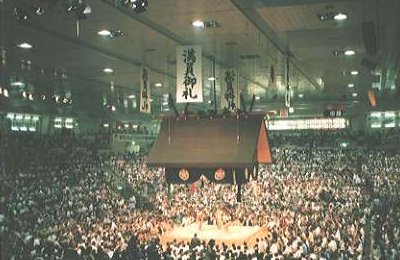
The sumo dojo is full of symbolism
Most of the Shinto that we see in sumo occurs symbolically. To begin with, the sand that covers the clay of the dohyo is itself a symbol of purity in the Shinto religion. And the canopy above the ring is made in the style of the roof of a Shinto shrine. The four tassels on each corner of the canopy represent the four seasons, the white one as autumn, black as winter, green as spring and red as summer.
The purple bunting around the roof symbolizes the drifting of the clouds and the rotation of the seasons. The referee (gyoji) resembles a Shinto priest in his traditional robe. And kelp, cuttlefish, and chestnuts are placed in the ring along with prayers for safety. Each day of the tournament (basho), a ring entering ceremony is held, wherein each wrestler’s body and spirit undergoes purification.
Yokozuna are dressed in mawashi with five white zigzag folded strips of paper on the front, the same as those found at the entrance of Shinto shrines. On the front of all mawashi are sagari, which are fringes of twisted string tucked into the belt, and they represent the sacred ropes in front of shrines.
Numbers of strings are odd, between seventeen and twenty-one, which are lucky numbers in the Shinto tradition. And of course, the salt that is tossed before each bout is an agent for purification and one of sumo’s most visible rituals. As a religion of customs and not laws, Shinto developed as a religion to please the gods in order to ensure a good harvest and divine protection, but soon made headway into the sport of sumo as a way to entertain those same gods, purify the sport itself and protect the wrestlers from harm.
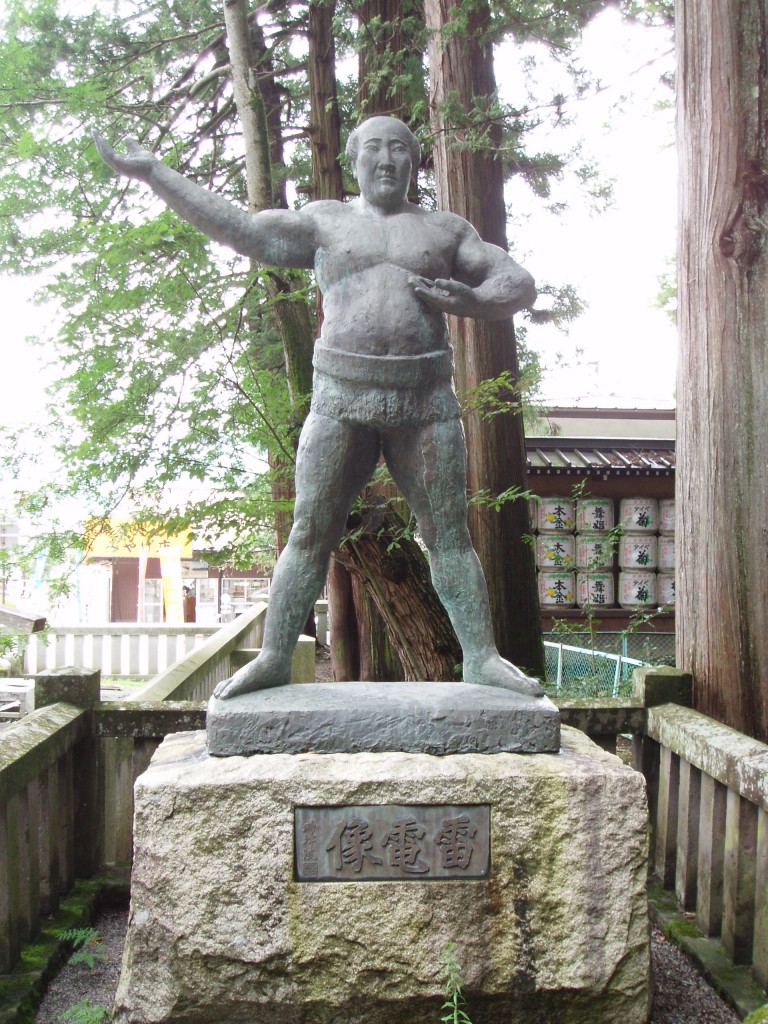
Statue of a sumo champion at Suwa Taisha, where matches are put on in a sumo dojo for entertaining the kami
The first ceremony of the day is the dohyo-iri, or ring ceremony performed by Juryo and Makuuchi wrestlers before their bouts begin. The wrestlers are grouped into two groups—East and West—and each group takes a turn entering the ring. The lowest-ranked wrestler enters first and walks a complete circle around the ring followed by the other wrestlers in ascending order according the rank.
Before individual wrestlers enter the ring, they are introduced to the spectators. Once the last wrestler in the group has been introduced, the wrestlers, who are facing the spectators, turn inward and face each other around the ring. After clapping their hands once, they raise their right hand, lift their kesho-mawashi (decorative aprons created for the ring ceremony), and finally raise both hands in unison.
This tradition goes back to the samurai days and represents the wrestler showing each other that none is armed. During the Makuuchi ring ceremony, the Yokozuna are notably absent from the group as they must perform their own individual ring ceremonies.
Once the actual bouts begin, the two wrestlers spend several minutes before their match lifting their legs high in the air and stomping them down, a practice said to scare away any demons. They also throw several handfuls of salt into the ring, which is said to purify the ring.
Many wrestlers will also sprinkle salt around their bodies as a means of protecting them from injury. After the last bout of the day, the bow twirling ceremony is performed by a wrestler from the same stable as a Yokozuna. True fans of the sport will not leave their seats until this ritual is performed. Presently, sumo consists of six major tournaments a year called basho. The tournament months and sites are as follows: January-Tokyo, March-Osaka, May-Tokyo, July-Nagoya, September-Tokyo, and November-Fukuoka.
Up through the early 20th century, there were only two basho a year; however, as sumo’s popularity grew, the number of major tournaments increased to four basho a year and then in 1958, the current six-basho-a-year format was established.
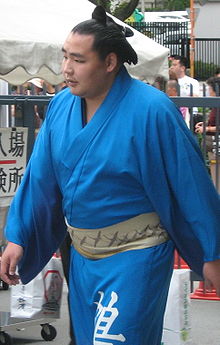
The latest yokozuna, the Mongolian Kakuryu
Also, up until 1949 a basho only lasted for 10 days; currently a basho runs for 15 days. In between basho, the wrestlers constantly keep busy by touring the outskirts of Japan giving exhibitions for fans who might otherwise not get a chance to see the sport up close and live. While the wrestlers do battle each other in front of the fans, they are more concerned about avoiding injury than winning. This type of exhibition sumo is called hana-sumo, or flower sumo.
Throughout the history of the sport, there is a record of only 71 wrestlers having ever been crowned as Yokozuna. Currently #69 Hakuho, #70 Harumafuji and #71 Kakuryu, all Mongolians, are actively fighting. Often, sumo eras are defined by the Yokozuna who fought in them.
In order to receive promotion to the rank of Yokozuna nowadays, a wrestler must win two tournaments in a row. To emphasize how difficult this task is, out of the hundreds of thousands of youngsters to have ever stepped in the ring only 70 have ever reached the pinnacle. In times past when there were no active Yokozuna, exceptions to the two tournament rule were made if a wrestler won one tournament and then followed that performance up with a record “worthy” of a Yokozuna.
**********************
For information about the new sumo museum in Tokyo, see here.
With regard to the ‘ring-entering ceremony’ based on Shinto ritual, the Wikipedia page on sumo notes… ‘Each day of the tournament the dohyō-iri, or ring-entering ceremonies performed by the top divisions before the start of their wrestling day are derived from sumo rituals.
This ceremony involves them ascending the dohyō, walking around the edge and facing the audience. They then turn and face inwards, clap their hands, raise one hand, slightly lift the ceremonial aprons, and raise both hands, then continue walking around the dohyō as they leave the same way they came in. This clapping ritual is an important Shinto element and reminiscent of the clapping in Shinto shrines designed to attract the attention of the gods.
The yokozuna’s ring-entering ceremony is regarded as a purification ritual in its own right, and is occasionally performed at Shinto shrines for this purpose. Every newly promoted yokozuna performs his first ring-entering ceremony at the Meiji Shrine in Tokyo.’
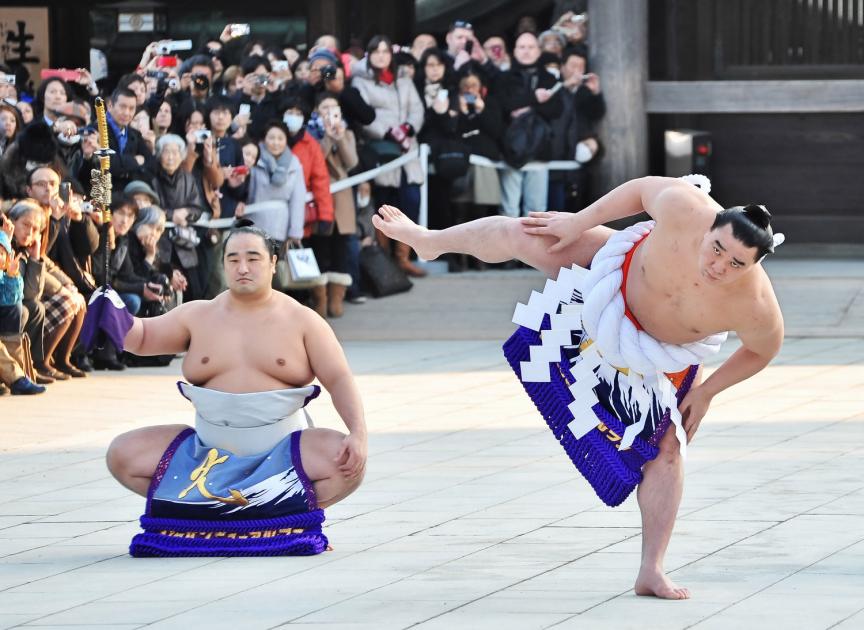

Leave a Reply